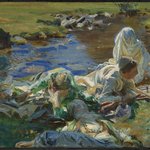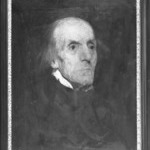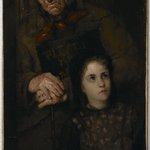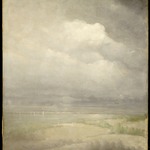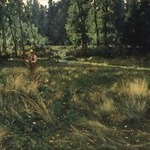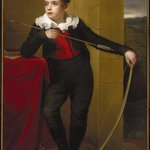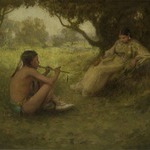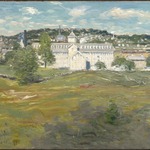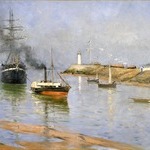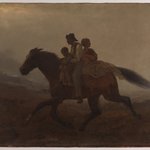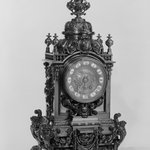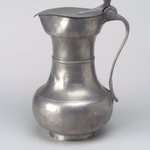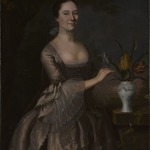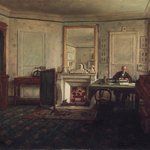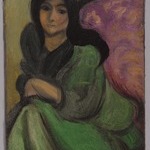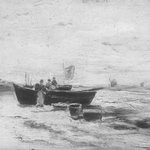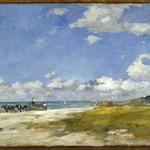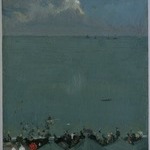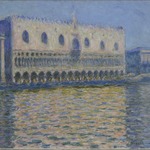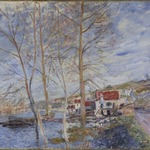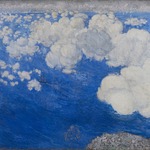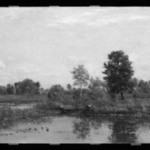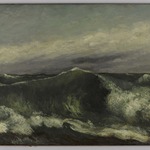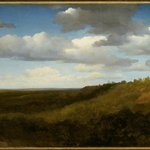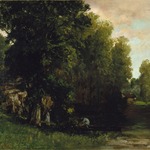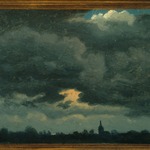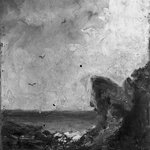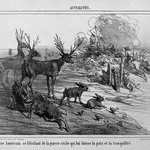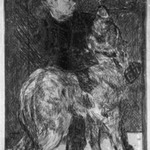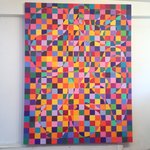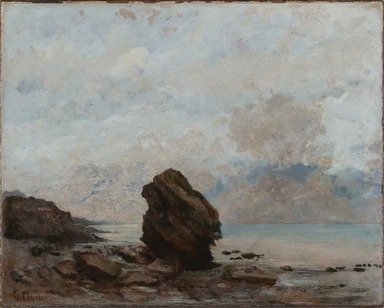
Isolated Rock (Le Rocher isolé)
Gustave Courbet
European Art
Gustave Courbet’s paintings of the shorelines in Normandy portray the land as subject to continuous, if gradual, change. Here, he focuses on a single large rock at the edge of the water. Smaller rocks around it and the several just visible above the surf imply an ongoing process of erosion. Applying his paint with a palette knife in broad, rough patches and strokes, Courbet evokes the windblown clouds and the coarse texture of the rock, giving them equal visual and material weight.
By the 1860s, Courbet was the leader and champion of Realism—a movement and approach that typically focused on contemporaneous people, places, and things and found significance in subject matter previously considered to be without artistic value or interest. He recounted his position as a Realist artist in an 1861 letter, stating, “Painting is an essentially concrete art, and can consist only of representation of real and existing things.”
By the 1860s, Courbet was the leader and champion of Realism—a movement and approach that typically focused on contemporaneous people, places, and things and found significance in subject matter previously considered to be without artistic value or interest. He recounted his position as a Realist artist in an 1861 letter, stating, “Painting is an essentially concrete art, and can consist only of representation of real and existing things.”
MEDIUM
Oil on canvas
DATES
ca. 1862
DIMENSIONS
25 1/2 x 32 in. (64.8 x 81.3 cm)
frame: 33 1/8 x 39 5/8 x 2 3/4 in. (84.1 x 100.6 x 7 cm) (show scale)



SIGNATURE
Signed lower left: "G. Courbet."
COLLECTIONS
European Art
ACCESSION NUMBER
41.1258
CREDIT LINE
Gift of Mrs. Horace O. Havemeyer
EXHIBITIONS
MUSEUM LOCATION
This item is not on view
CAPTION
Gustave Courbet (French, 1819-1877). Isolated Rock (Le Rocher isolé), ca. 1862. Oil on canvas, 25 1/2 x 32 in. (64.8 x 81.3 cm). Brooklyn Museum, Gift of Mrs. Horace O. Havemeyer, 41.1258 (Photo: Brooklyn Museum, 41.1258_PS11.jpg)
IMAGE
overall, 41.1258_PS11.jpg. Brooklyn Museum photograph, 2022
"CUR" at the beginning of an image file name means that the image was created by a curatorial staff member. These study images may be digital point-and-shoot photographs, when we don\'t yet have high-quality studio photography, or they may be scans of older negatives, slides, or photographic prints, providing historical documentation of the object.
RIGHTS STATEMENT
No known copyright restrictions
This work may be in the public domain in the United States. Works created by United States and non-United States nationals published prior to 1923 are in the public domain, subject to the terms of any applicable treaty or agreement.
You may download and use Brooklyn Museum images of this work. Please include caption information from this page and credit the Brooklyn Museum. If you need a high resolution file, please fill out our online application form (charges apply).
The Museum does not warrant that the use of this work will not infringe on the rights of third parties, such as artists or artists' heirs holding the rights to the work. It is your responsibility to determine and satisfy copyright or other use restrictions before copying, transmitting, or making other use of protected items beyond that allowed by "fair use," as such term is understood under the United States Copyright Act.
The Brooklyn Museum makes no representations or warranties with respect to the application or terms of any international agreement governing copyright protection in the United States for works created by foreign nationals.
For further information about copyright, we recommend resources at the United States Library of Congress, Cornell University, Copyright and Cultural Institutions: Guidelines for U.S. Libraries, Archives, and Museums, and Copyright Watch.
For more information about the Museum's rights project, including how rights types are assigned, please see our blog posts on copyright.
If you have any information regarding this work and rights to it, please contact copyright@brooklynmuseum.org.
RECORD COMPLETENESS
Not every record you will find here is complete. More information is available for some works than for others, and some entries have been updated more recently. Records are frequently reviewed and revised, and we welcome any additional information you might have.

